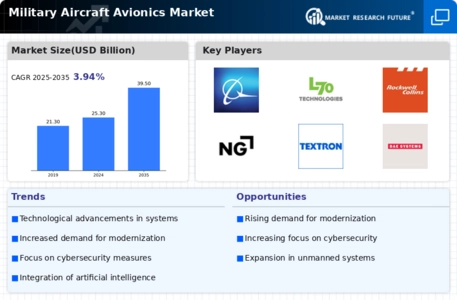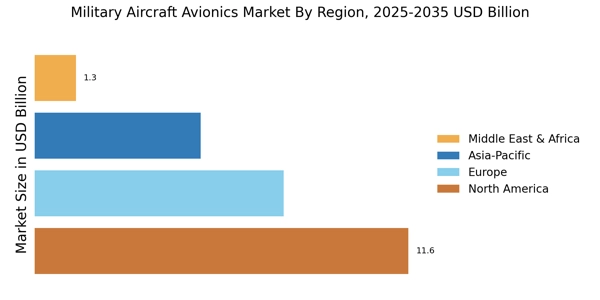Increased Defense Spending
The Military Aircraft Avionics Market is poised for growth due to increased defense spending across various nations. Governments are allocating substantial budgets to modernize their military fleets, which includes upgrading avionics systems. According to recent data, defense budgets are projected to rise by approximately 3% annually over the next five years, with a significant portion earmarked for avionics enhancements. This trend is particularly evident in regions with heightened geopolitical tensions, where nations are investing in advanced military capabilities. Consequently, the Military Aircraft Avionics Market is likely to benefit from this influx of funding, as defense contractors seek to provide state-of-the-art avionics solutions.
Technological Advancements in Avionics
The Military Aircraft Avionics Market is experiencing a surge in technological advancements, particularly in the areas of digital avionics and integrated systems. Innovations such as advanced flight control systems, enhanced navigation capabilities, and improved communication technologies are becoming increasingly prevalent. These advancements not only enhance operational efficiency but also improve the safety and reliability of military aircraft. For instance, the integration of artificial intelligence and machine learning into avionics systems is expected to streamline decision-making processes and reduce pilot workload. As a result, the demand for cutting-edge avionics solutions is likely to grow, driving the Military Aircraft Avionics Market forward.
Focus on Enhanced Situational Awareness
The Military Aircraft Avionics Market is increasingly driven by a focus on enhanced situational awareness for military operations. Modern avionics systems are being designed to provide pilots with real-time data and comprehensive battlefield information, which is crucial for mission success. Technologies such as synthetic aperture radar, advanced sensors, and data fusion capabilities are being integrated into military aircraft to improve situational awareness. This trend is expected to lead to a rise in demand for sophisticated avionics solutions that can process and display critical information effectively. As military operations become more complex, the Military Aircraft Avionics Market is likely to see a corresponding increase in the adoption of these advanced systems.
Emphasis on Cybersecurity in Avionics Systems
The Military Aircraft Avionics Market is increasingly emphasizing cybersecurity as a critical component of avionics system design. With the rise of cyber threats targeting military assets, there is a pressing need for robust security measures to protect sensitive avionics data and communication channels. Manufacturers are now focusing on developing avionics systems that incorporate advanced encryption, intrusion detection, and secure communication protocols. This heightened focus on cybersecurity is expected to drive demand for innovative avionics solutions that can withstand potential cyberattacks. As military operations become more reliant on interconnected systems, the Military Aircraft Avionics Market is likely to see a significant shift towards incorporating cybersecurity features into avionics design.
Growing Demand for Unmanned Aerial Vehicles (UAVs)
The Military Aircraft Avionics Market is witnessing a growing demand for unmanned aerial vehicles (UAVs), which are increasingly being utilized for reconnaissance, surveillance, and combat missions. The integration of advanced avionics systems in UAVs is essential for their operational effectiveness, as these systems enable autonomous flight, navigation, and data collection. Recent estimates suggest that the UAV segment of the military aviation market could account for over 30% of total military aircraft expenditures in the coming years. This shift towards UAVs is likely to drive innovation and investment in the Military Aircraft Avionics Market, as manufacturers strive to develop specialized avionics solutions tailored for these platforms.


















Leave a Comment